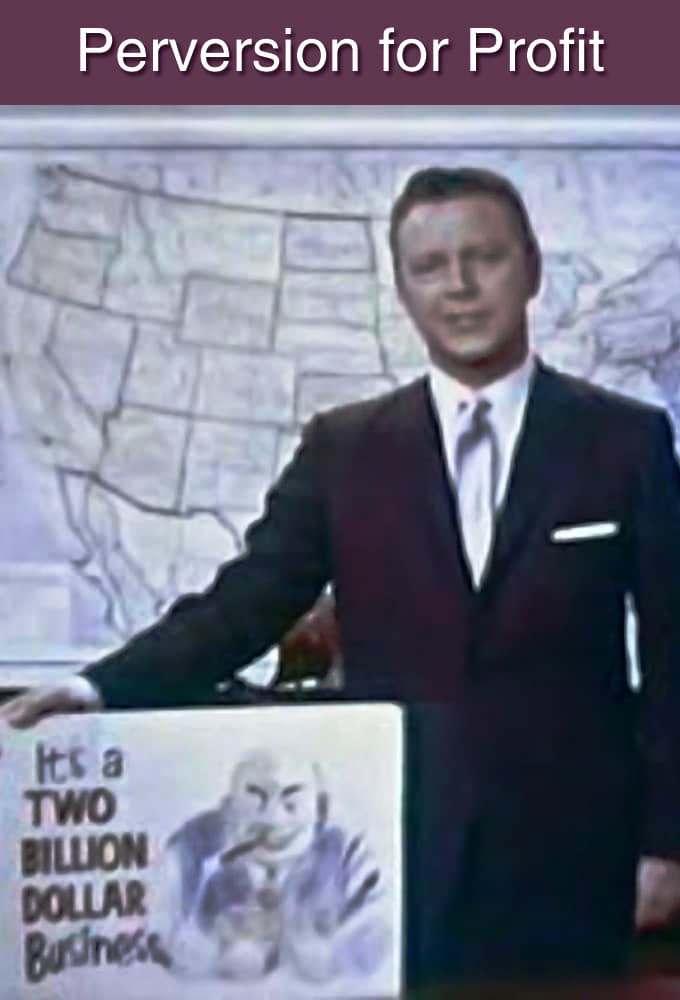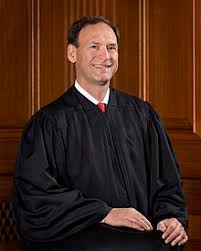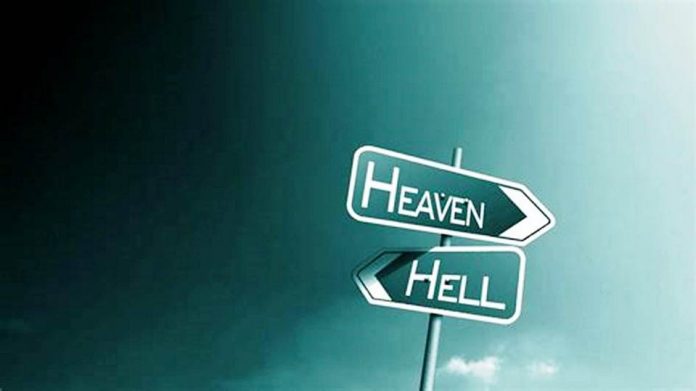A propos of nothing, something grabbed my attention the other night, causing me to revisit a phenomenon that has long since disappeared from the public radar.
It was one of those public service documentaries, the sort we haven’t seen in decades. Titled Perversion for Profit and made in 1965, it appeared on TCM.
 All about pornography and the insidious destruction it unleashes, this particular doc was narrated by George Putnam, a then well-known broadcaster who railed on about the many dangers of pornography — not just to the individual, but to the entire society and culture. And how pornography in all its forms — including magazines, books and films – addicts the user in subtle ways, ultimately twisting the psyche into unnatural pathways — particularly homosexuality — from which, according to the narrator, it’s almost impossible to escape.
All about pornography and the insidious destruction it unleashes, this particular doc was narrated by George Putnam, a then well-known broadcaster who railed on about the many dangers of pornography — not just to the individual, but to the entire society and culture. And how pornography in all its forms — including magazines, books and films – addicts the user in subtle ways, ultimately twisting the psyche into unnatural pathways — particularly homosexuality — from which, according to the narrator, it’s almost impossible to escape.
How quaint it all seemed. How antiquated, even extreme, especially the bit about homosexuality. Is this true? Who was this Putnam person anyway and why was he broadcasting a warning so intense and so loud it seemed, well, over-the-top?
Which is when it hit me. When was the last time I’d even heard such a message at all? High school maybe?
And that was years, even decades ago, that our health teacher gave a class instructing us about porn, its forms and its dangers which were, frankly, too embarrassing to think about, let alone discuss openly. And so when the bell rang, we bolted for our next class, though somewhere in our teen consciousness, we were certainly aware of Hugh Hefner, his burgeoning Playboy magazine empire and related competitors.
That was then.
After watching this 40-minute documentary, however, I realized that porn had slipped off the day-to-day cultural screen. I mean, with transgenderism as the current topic du jour, when’s the last time you heard pornography raised as a serious issue, threatening public morals, mental health and even safety?
Yet the foul moral atmosphere it creates remains with us 24/7, like a carbon monoxide of the soul. Undetectable but lethal. And everywhere.
Porn as Big Business
That the porn business has exploded exponentially was confirmed in May by the New York Times which ran a cover story titled ‘Naked Capitalists: There’s No Business Like The Porn Business.’ Its thesis: Pornography is big business with $10 billion to $14 billion in annual sales. Moreover, author Frank Rich suggests that pornography is bigger than any of the major league sports, perhaps bigger than Hollywood and “no longer a sideshow to the mainstream…it is the mainstream,” he writes.
Which was confirmed in a recent ranking of the world’s top websites. Among the top 20 in the North America alone, there are five porn websites – one based in Montreal – ranking in amongst Google, Facebook, Youtube, Amazon, Instagram, Reddit, Craigslist, Netflix and so on.
Five websites out of 20! That’s a lot of porn consumption. Yet we’re supposed to believe what? That this gargantuan level of porn consumption is without consequence? Without social impact? Without result?
There are naysayers, of course, who claim the profits are hugely over-estimated. And that for the $10 billion figure to be accurate, you’d have to add in adult video networks and pay-per-view movies on cable and satellite, websites, in-room hotel movies, phone sex, sex toys and magazines — and still you can’t get there.
Regardless, the numbers are staggering.
Which brings me back to Putnam and his startling allegations which, among them, argue that sexually explicit materials corrupt young viewers and readers, potentially leading to acts of violence and ‘perverted’ attitudes towards sex – including encouraging/triggering an inclination towards homosexuality.
Dr. Pitirim Sorokin
All of which is supported by the documentary’s adviser, Harvard sociologist Dr. Pitirim Sorokin, said to be one of the giants of 20th century social thought. The founding chairman of Harvard’s sociology department, Sorokin authored over thirty books in his lifetime, many of them weighty tomes displaying encyclopaedic knowledge of specialized scholarship in no less than six European languages. In terms of the scope and focus of his interests he is also said to be most readily compared to Comte, Tocqueville, and Weber, though in terms of the sheer breadth and weightiness of his literary output he even overshadows these.
 Ever heard of Sorokin? Nor had I.
Ever heard of Sorokin? Nor had I.
Nevertheless his sociological findings and predictions are today being confirmed in every aspect of western culture. “American society has become obsessed with sex,” Sorokin declared in his book The American Sexual Revolution: “In the last few decades, our civilization has become so preoccupied with sex that it now oozes from all pores of American life… Whatever aspect of our culture is considered, each is packed with sex obsession. Its vast totality bombards us continuously, from cradle to grave, from all points of our living space, at almost every step of our activity, feeling, and thinking… And it is changing the lives of men and women more radically than any other revolution of our time.”
And among the greatest drivers of this revolution has been pornography which has now become so inculturated that most fail to notice its perpetual presence. Or that youngsters long ago abandoned the restricted shelves of their local convenience store in favour of online porn sites where they can indulge their habit with abandon.
Nor has the construction of the porn industry been spontaneous or accidental.
Literary giants join the trend
As far back as the 1950s and even earlier, Sorokin was noting how almost all eminent American authors of the mid-20th century were feeling the pressure to pay homage to sex in order to increase their book sales, either by making it the central theme of their work or by devoting to it a good deal of attention even in books focused on entirely different topics. Most significant, Sorokin observed, was that so many of these authors — including serious writers such as Theodore Dreiser, Sinclair Lewis, Eugene O’Neil, Ernest Hemingway and John Steinbeck — were portraying sexual excesses and sexual misconduct as if such behaviour was perfectly normal and acceptable.
This was a dramatic change from the practice of the great novelists of the 19th century such as Tolstoy and Flaubert who “depicted illicit passion as a tragedy for which hero and heroine alike paid with their lives or by long suffering,” Sorokin explained. “By contrast, most of the adulteries and other sins treated in contemporary literature are considered by the authors enjoyable adventures in the monotonous existence of modern men and women.”
Such depictions, he concluded, were certain to weaken commitment to marital fidelity and to demoralize rather than integrate the many conflicting passions, sexual and otherwise, that exist within the human soul. Meaning that sex obsession in what Sorokin called “pulp” or “sham” literature — i.e. the junk novels and mass market paperbacks that Putnam presented in the documentary — was even more pronounced and more degrading than that in more serious literature.
So why was Putnam and his sponsors sounding the alarm in theatres in 1965? Because at that point, the porn market was seeping into every corner of society because the merchants of obscenity now had the means for mass marketing their filth and putting it within easy reach of every man, woman and child in the West.
So far, so predictable, you might say.
What jumps out of this particular documentary, however, is its associations between porn consumption and all forms of deviance, including homosexuality, suggesting that the former may encourage the latter in which, once involved in it, it’s almost impossible to return.
This is so politically incorrect, I know, but when was the last time you heard such a thing? Or ever? And today would such an association/connection even be permitted to be made in today’s culture which has long been normalizing every activity once regarded as deviant or inexplicable, including transgenderism?
Then and now
In his writings, Sorokin describes the harmful effects on the sensitive and finely calibrated human psyche when it is allowed a steady diet of pornography. Apart from devitalizing whole cultures and family lines, he writes, pornography indulgence upsets the delicate psychic equilibrium of the countless individuals who succumb to its allure. Sorokin adds that contrary to the image created by much of modern literature, psychology and film, the inner world of these so-called ‘sexually liberated’ is one of inner turmoil and tension. Dominated by his lusts and sexual desires, and perpetually bombarded by external stimuli that challenge his weak internal control mechanism, the porn-consumer quickly becomes a house divided against itself and in search of ever newer sexual thrills. In such a situation, writes Sorokin, the libertine cannot achieve real peace of mind. He is subject to alienation, depression and a variety of mental disturbances — not to mention the danger of venereal disease, unwanted pregnancies, violence and the possibility of being harmed by an aggrieved party. Plus, he usually must lie or dissimulate about what he is doing.
In other words, sexual liberation, Sorokin contends, is really not what it’s cracked up to be in so much of our modern art, literature, movies, and songs.
As for the neurological impact of pornography, the American Conference of Bishops concurs. According to their website, www.usccb.org:
“Pornography is believed to function like a “drug” that stimulates the brain. Neuroscientists point to three fundamental effects that addiction has on the brain: 1) “desensitization,” a numbing of the brain’s ability to experience pleasure; 2) “sensitization,” an increased sensitivity to triggers and memories related to the addictive behavior; and, 3) “hypofrontality,” the reduced activity of the frontal brain, decreasing impulse control and creating a negative mood. These effects remind us that pornography robs our joy, and where there is little joy, there is often never enough pleasure.
Purity answers Vice
The answer? The Catholic Catechism provides it. For all time, all places and all situations, it is the abiding virtue of Purity, the practice of which can produce only goodness and peace of mind, which vanished from the public square years ago, along with the decency that Purity’s graces provide.
What’s more, the Catechism teaches clearly and succinctly about all violations of the ninth commandment which warns against lust or carnal concupiscence; that the struggle against carnal lust involves purifying the heart and practicing temperance; that purity of heart will enable us to see God and even to see things according to God; that the purification of the heart demands prayer, the practice of chastity, purity of intention and of vision; and that purity of heart requires the modesty which is patience, decency and discretion while modesty protects the intimate center of the person.
All true. And as unchanging today as it was 2,000 years ago and will be into the future.
What’s more, its practice – or lack of it — makes the difference between civilization and the moral anarchy we’re witnessing today.
Homosexuality and Porn
Which brings me back to Putnam’s observation about the purported connection between homosexuality and porn. Has this connection ever been seriously investigated in recent years? And if not, why not?
The simple answer is that the truth is not wanted because it conflicts with the direction the culture is taking us. Which was confirmed in 2015 by associate justice Samuel Alito of the U.S. Supreme Court when he noted the joint rise of sexual anarchy and anti-Christian bigotry.
 In his dissent from the 2015 Supreme Court decision in the case that required all states to recognize same-sex marriage, Justice Alito predicted that the decision would “be used to vilify Americans who are unwilling to assent to the new orthodoxy.”
In his dissent from the 2015 Supreme Court decision in the case that required all states to recognize same-sex marriage, Justice Alito predicted that the decision would “be used to vilify Americans who are unwilling to assent to the new orthodoxy.”
Alito strongly doubted the Supreme Court majority’s reassurance that the conscience rights of those who maintain a traditional view of marriage would be protected.
“We will soon see whether this proves to be true. I assume that those who cling to old beliefs will be able to whisper their thoughts in the recesses of their homes, but if they repeat those views in public, they will risk being labeled as bigots and treated as such by governments, employers, and schools,” Alito wrote then.
How quickly he was proved right. And how quickly has the tone shifted from one of assurances that same-sex marriage would have no effect on those who did not believe such a union was a real marriage.
Since then, the vindictiveness of the victors toward the vanquished has been swift and relentless as the progressives’ determination to go after Christians holding traditional views about sexual morality becomes ever more pronounced.
Since the Supreme Court decision, small businesses owned by Christian bakers, florists and photographers have been targeted aggressively by pro-LGBT organizations and some driven out of business by ruinous lawsuits. “Live and let live!” has given way to “bake the cake, bigot!”
Overheated as the anti-Christian rhetoric may be, it points to a profound divide that has become more evident than ever before.
Today, views of sex, virtue and marriage that had been uncontroversial across the political spectrum for centuries have now become incomprehensible to cultural elites who reject the biblical condemnation of fornication, adultery and homosexual acts. In their anti-Christian, sexually liberal view, this strict sexual morality simply demonstrates the irrational and pleasure-denying nature of the Judeo-Christian God.
But this is to deny the very rationality of God and His divinely created order, in which by following His commandments mankind flourishes as individuals, families, and societies. Indeed, it is the very following of the moral law that makes men free to live and thrive without the destructive habits or vices that enslave them.
And all of human history confirms this.
Choosing Death
What is most striking about the new progressive orthodoxy, however, is the extent to which it is based on a denial of reality, breaking the links that connect marriage to sex and both to children, and stripping from marriage any clear rationale for its central features —an exclusive sexual union between a man and a woman in a social context that supports the bearing and raising of children and the practise of virtue. Instead, marriage is reduced to a kind of state-registered friendship, with no rationale for sex as a defining feature, for exclusivity, or for sexual complementarity.
And the disastrous results of this sexual revolution for women, children and the flourishing of society are clear and undeniable. Including statistics released last month that indicated that life expectancy in North America is now reversing, due largely to opiod overdoses and suicides which, in turn, are related to the explosion of mental – and dare I say ‘moral’ – illness now in the open across the West.
One might also ask what role pornography has played in all this disordering of the public mind?
Yet, as Putnam would have observed, all the above can be easily predicted, as it is precisely this type of moral decay that caused sixteen out of the nineteen major civilizations of human history to vanish from the Earth.
“(God’s) laws are on our side,” Putnam concluded near the end of the documentary. “We have a constitutional guarantee of protection against obscenity. And, in this day especially, we must seek to deliver ourselves from this twisting, torturing evil. We must save our nation from decay and deliver our children from the horrors of perversion. We must make our land, ‘the land of the free’, a safe home. Oh, God, deliver us, Americans, from evil.”
But I am also reminded of the famous quote by Edmund Burke who declared that “the only thing necessary for the triumph of evil is for good men to do nothing.”
But isn’t it also true that good men who do nothing are no longer ‘good?’

